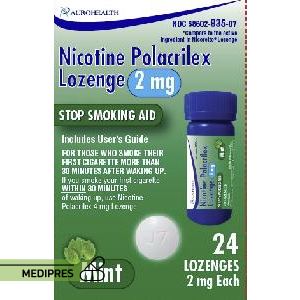
Eprontia
23 June, 2023
Ergotamine and caffeine (Oral)
23 June, 2023Equate Nicotine Lozenge
Generic name:
Nicotine
Drug class:
Nicotine Replacement Therapy; Nicotinic receptor agonist
Dosage form:
Lozenge (2 mg, 4 mg)
Root of administration:
Oral
Dose:
- 2 mg or 4 mg per lozenge
- Initiate 1 lozenge every 1–2 hours as needed during first 6 weeks
- Taper schedule:
- Weeks 7–9: 1 lozenge every 2–4 hours
- Weeks 10–12: 1 lozenge every 4–8 hours
- Maximum 20 lozenges per day
Mechanism of action:
Nicotine binds to nicotinic acetylcholine receptors in the central nervous system, stimulating dopamine release to alleviate withdrawal symptoms associated with smoking cessation.
Drug usage cases:
- Smoking cessation aid for nicotine dependence
- Tobacco use disorder
- Off-label: Tobacco harm reduction in smokers
Drug contra indications:
- Hypersensitivity to nicotine or any component of the lozenge
- Recent myocardial infarction (within 2 weeks)
- Serious or life-threatening arrhythmias
- Unstable angina pectoris
Side effects:
- Nausea
- Hiccups
- Heartburn
- Headache
- Insomnia
- Dizziness
- Cough
- Pharyngitis
- Oral or throat irritation
- Dyspepsia
- Diarrhea
- Vomiting
- Rash
- Palpitations
- Hypersensitivity reactions
Warnings:
- May increase cardiovascular risk in patients with underlying heart disease
- Avoid concurrent use of other nicotine-containing products to prevent overdose
- Use with caution in peptic ulcer disease or gastrointestinal disorders
- Potential for arrhythmias in susceptible individuals
- Contains menthol flavor; may irritate oral mucosa
- Risk of dependence and misuse
Use during pregnancy or breastfeeding:
Nicotine crosses the placenta and is excreted in breast milk. Use during pregnancy may lead to adverse fetal outcomes such as low birth weight and preterm delivery. Behavioral interventions are preferred for smoking cessation in pregnant patients; if pharmacotherapy is necessary, use the lowest effective dose and discontinue as soon as possible. During breastfeeding, nicotine in breast milk may cause tachycardia and irritability in the infant; weigh the benefits of maternal smoking cessation against potential neonatal risks.



